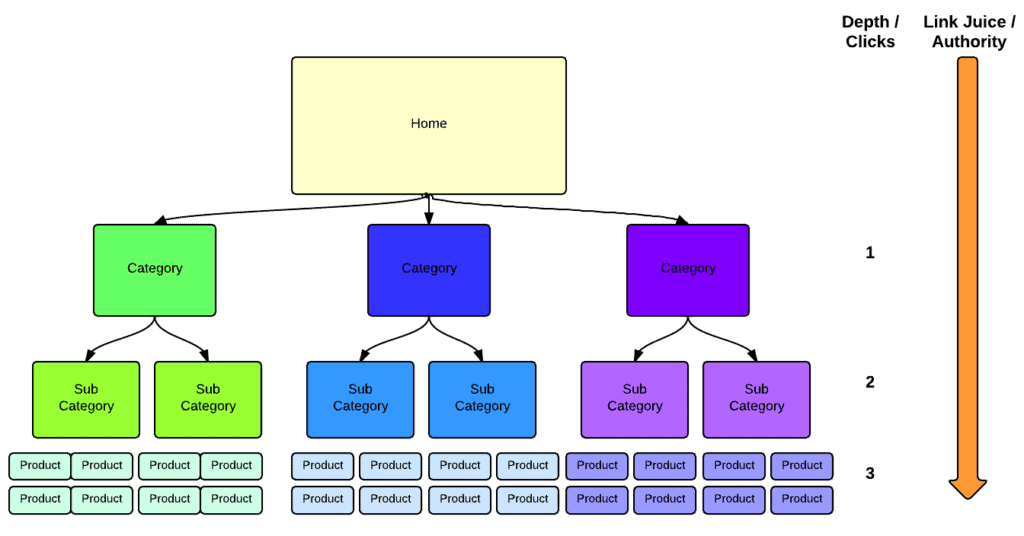/
SEO
/
0 min read
Webshop SEO: 11 effective steps for organic growth

Page speed: Most online mobile shoppers are going to leave again if your front page doesn’t load in less than 5 seconds. Improving your page speed is a technical effort. You have to optimize the code, optimize images and make sure you keep redirects to a minimum. Try testing your website using PageSpeed Insights.
Avoid annoying elements like pop-ups, newsletter subscription forms, and similar things. While it might seem like a good way to attract customers, it will often have the opposite effect. This is because a lot of users experience these elements as intrusive and obstructive. It can also confuse and misdirect the user. Something that Google definitely doesn’t like.
User-friendliness, user-friendliness, and – you guessed it – user-friendliness. Design your webshop so it matches all types of users. All age groups use mobile devices now. So you have to make sure that the text is big enough and visible enough for all grades of vision. You also have to think about designing for “fat fingers” - nobody should have a disappointing user experience because they accidentally pressed the wrong button because it’s too close to another.
Companies with integrated online blogs get 97% more links
B2B sites with blogs get 67% more leads
Websites with blogs have 434% more indexed pages on search engines.
Placement: The CTA should be easy to see and should jump out of the page with a contrasting color.
Copy: The CTA should be easy to figure out. Don’t mince your words and express yourself concisely and precisely.
Testing: Experiment with different CTA’s to see what works best. Consider split-testing it.
Mouseflow
Hotjar
CrazyEgg
Sneakers, the newest iPhone, or a two-person trip to New York.
These are just a couple of examples of what several million people search for each day on Google. Does your webshop sell any of these? Or maybe something different?
If you do, it’s extremely important that your webshop stands out from the competition. That is if you want to increase your chances of potential customers entering your website and not anyone else's.
This is where webshop optimization and SEO enter the conversation.
In this guide, we’ll teach you to create better visibility and higher revenues through webshop optimization.
1. Optimize your keywords
In this article, we’re focusing on webshop SEO. If you’re new to the area of organic growth, we can’t stress enough how important it is to know more about search engine optimization.
If you want your products to rank on the first page of Google, you need to find the keywords that customers are actually searching for. Because if you know what your customers are looking for, you can write product descriptions that match exactly that. This increases your chances of having product pages that are unique and competitive.
By using Ubersuggest (or another similar SEO tool) you can get the details on how often keywords like “running shoes” are searched for. You can also see how difficult they are to compete for and much more.
To add to your research tasks, you can also use Google to find out what your competitors write about and how they manage to make it to the top of the search results.
It’s important to note, however, that you should limit your optimization efforts to a single keyword per product page. First off, it makes it easier for Google to figure out what you’re offering. Secondly, it makes it much easier for you to handle. And you’ve probably got enough on your plate as it is.
2. Build a good structure for your webshop and make it manageable
A successful website is manageable, organized, and simple. Not just because it makes it easy for Google to understand the contents of it, but also because customers nowadays want to find what they’re looking for easily and swiftly.
Especially if you have a ton of products.
So think about how your website should be designed and structured. Try to make it as user-friendly as possible. There are quite a lot of webshop designs out there, but we recommend the following simple and flat structure that works every time.

You want your customers to find any given product on your page in max 3 clicks from the front page.
It works in two ways: It shows Google that you think your products are valuable and it keeps customers on your site because they can find what they’re looking for.
Nobody wants to click through 15 pages to find the product they’re searching for. They’ll click the back button instead.
As a next step, make sure to make the text content of your pages easy to read and try to include your chosen keyword in both the title, any headings, and the meta description.
If you do that, you ensure a good user experience for any potential customers. It also makes your site look a lot more trustworthy and professional.
3. Make your webshop mobile-friendly
Over half of all online traffic comes from mobile devices. And for each year, that ratio will probably increase.
So if your webshop is mobile-friendly, Google’s algorithms are going to reward your webshop. If it isn’t, you’ll get punished. Simple as.
If your website isn’t optimized for mobile friendliness, it’ll be very tough to reach the top ranks of Google. It’ll also be really hard to satisfy your visitors. Those two are always linked intimately when it comes to webshop SEO
So, we’re going to explain to you how to make your webshop both inviting and user-friendly for all visitors:
You can read more about this in our guide to Core Web Vitals.
4. Release your inner writer and start publishing blog content
Google loves fresh and up-to-date content. By starting a blog you can write interesting content for your website. It can be anything from product and industry news to how-to guides or other services your webshop provides.
This will show users that your website is actively maintained and updated. You can also highlight specific products or categories that you think your customers should know more about.
Quick stats:

Not convinced yet?
A blog is also an easy way to create internal link building on your webshop. This means you can guide visitors to specific products or categories. Or the other way around: if you have products that require a bit of know-how, you can easily guide customers on how to use them.
Let’s say you write a guide on how to match your running style to specific running shoes. Here you can link to the specific models of shoes that a visitor can buy. It’ll also show that you have knowledge and expertise about the products you’re selling. And that you want to help your customers succeed.
That’s good salesmanship and good SEO.
5. Make your website secure and safe
In 2017, Google made some changes to its algorithms in order to promote better online safety. This means that websites that don’t encrypt data will be marked as “Not safe” and will likely be demoted in their rankings.
The “Not safe” label is shown in the address bar and is visible to anyone entering your site. It would be like having a “Fire hazard” sign on the front door of your building. Not good for business.

Especially if you’re a webshop that handles sensitive credit card information. You want to signal safety and trustworthiness. If you don’t, you’ll likely lose a lot of potential customers.
So how do you avoid this embarrassing label of being unsafe?
Well, you need to implement HTTPS if you haven’t already. This is done by installing an SSL certificate on your website.
The transition from HTTP to HTTPS can be a bit technical if you weren’t born with a keyboard in your hands. You can save a lot of time and bother by leaving it to a specialist agency.
6. Optimize your click-through rates
The title and meta description of your page is what is shown on Google’s result page. It’s sometimes referred to as a “SERP snippet”

The point of the SERP snippet is to let searchers know what they can expect. The point for you as a webshop owner is to increase your CTR (click-through rate).
CTR is a metric that tells you what percentage of searchers click your result instead of any others. It’s also likely a ranking factor:
Low CTR -> Google thinks your site is not attracting visitors and will be demoted.
High CTR -> Your site attracts visitors and will be promoted.
If you haven’t added titles and descriptions yourself, Google will build it for you by pulling from your pages. This can often look a bit messy and leaves it out of your control. And since it likely doesn’t give the best description of what your visitors can expect, they’re less likely to click.
So if your webshop’s CTR is low it’s a clear sign that your SERP snippets aren’t what they could be. So there’s a lot of value to create by actively adding titles and descriptions to all your important pages.
You want the actual titles and descriptions to be descriptive and enticing without promising anything you can’t keep. So create interest without click bait, and explain without confusing.
7. Call-to-Action (CTA)
Use strategic call-to-action elements to guide visitors around your website and to make them act how you want. CTA’s are one of the most important elements for lead generations and - if used correctly - can take your conversion rates to the moon.
CTA’s can be used for several different purposes: sign-ups to your newsletter, trial sign-ups, adding products to a card, and much more.
An example of a great CTA that most of us probably fell for is this:

One part of what makes this CTA enticing is the “Cancel at any time”-disclaimer. It also promises you “Unlimited films..” and the ability to “Watch anywhere.” Chances are that you’ll get addicted to one of these unlimited films and extend your membership.
The other part is that the button explains very precisely what happens when you press it. You enter your email and you get started.
There’s no doubt in the binge-watching user’s mind about what’s going to happen next.
An example of a classic webshop that masters the CTA is ASOS:

On ASOS’s front page you are met with a CTA, “Shop the edit.” It’s placed directly in the golden section on top of some eye-catching imagery. As a visitor, you are being handheld as you’re guided further into the depths of ASOS's impressive catalog.
The buttons and links continue throughout the site and guide the visitor straight to their final destination: the shopping cart.
3 important things for CTA success
If you also have a blog you need to use strategic calls to action here as well. Place them throughout your blog posts to guide visitors to the product pages. Users will likely only find the pages you show them.
8. Create high-quality, unique content
One of the key factors that search engines use to rank websites is the quality of their content. If your product pages and blog posts are well-written, informative, and provide value to your visitors, search engines will recognize this and reward you with higher rankings.
To create high-quality content, you should focus on providing solutions to your customers' problems, addressing their pain points, and providing valuable information and insights. Avoid using excessive keywords, repeating the same information, or copying content from other websites, as this can hurt your rankings and harm your reputation.
9. Use social media to promote your webshop
Social media platforms can be a great way to drive traffic to your webshop and increase your visibility online. By posting regular updates, engaging with your followers, and sharing your products and blog posts, you can build a loyal audience and drive more traffic to your website.
To get started, create accounts on the most popular social media platforms, such as Facebook, Twitter, and Instagram, and start sharing your content and products. Be consistent, use hashtags, and engage with your followers to build a community and drive more traffic to your website.
Your SEO will not be directly strengthened by the social media presence, however, creating engagement can lead to passively gaining valuable backlinks. There is a statistical correlation between the number of social shares and the number of backlinks, through social media acting as a source of content distribution.
Increasing brand recognition and enhancing brand reputation through the usage of social media is also a way to strengthen the organic CTR, meaning increasing the likeliness of a person clicking on the webshop when actually showing up in the search results.
Lastly, generating commercial traffic is also the end goal of a business, whether it comes from Google's organic results or through social media.
10. Monitor and track your performance
To know if your webshop SEO efforts are working, you need to monitor and track your performance regularly. Using tools such as Google Analytics (or the more GDPR-friendly alternatives such as Matomo) and Google Search Console, you can see how much traffic your website is getting, what keywords are bringing you the most traffic, and how well your pages are performing.
You can also use these tools to identify potential issues, such as broken links, slow page speed, or low-quality content, and take action to fix them. By monitoring your performance regularly, you can make informed decisions, improve your webshop, and increase your visibility and revenue.
11. Stay up-to-date with the latest developments and trends
The world of webshop SEO is constantly changing, with new algorithms, techniques, and trends emerging all the time. To stay ahead of the competition, you need to keep up-to-date with the latest developments and trends in the field and adapt your strategies accordingly.
To do this, you can read industry blogs, follow experts on social media, attend conferences and workshops, and participate in online forums and communities. By staying informed and learning from others, you can improve your skills, stay ahead of the game, and maximize the success of your webshop.
General advice
Marketing plan
The first thing you want to get done is your marketing plan. It’ll shape the strategies to use in order to reach your desired customers and win a larger market share.
Obviously, you want a digital focus. Most people shop online. And for online shopping, no channel is bigger than Google. So you have to be present here if you want a passive channel for customer acquisition.
The marketing tactic that is most likely to give the best return on investment is SEO. Through SEO you optimize your rankings on Google and passively make yourself visible to new customers. In the long run, it’ll give you the most bang for your buck.
Google Analytics – analyze and understand your visitors
If you own a webshop with several products it’s important to know what products are the most attractive. Otherwise, you’ll quickly lose track of which products convert well and stand out.
So we recommend that you use Google Analytics. It’s a quick and easy way to get a ton of valuable data from your visitors. It’ll help you remove old products that don’t sell. It’ll also show you which products to focus your marketing efforts on.
You can read about how you set up Analytics right here.

Heatmaps – see your customer’s journeys
Why aren’t your visitors converting?
This is a question all website owners have asked themselves at some point.
It’s a self-evident truth that you can increase sales by getting more traffic - either through webshop SEO or through paid ads.
But you can also increase sales by making the visitors you do have to convert more.
The first step is keyword analysis. You want to pick keywords that bring in the right kind of people. Yeah yeah, you might have written the perfect guide on picking up the right running shoes. But that’s not going to help you if you only sell jewelry.
The second step is to analyze your customer journeys. In other words, what your visitors actually do after landing on your website.
A good tip is to start off with Google Analytics. As mentioned above, they provide a ton of helpful data. You can start with the Behaviour Flow report found under Behaviour in the left-hand panel.

But if you really want to know what your visitors do, why not get it registered correctly?
You can do this using heatmaps and session recording. Heatmap software records your users (anonymously, of course) as they click, scroll, and move around your website. By knowing this you can figure out what your non-converting visitors do - and optimize accordingly.
There are a lot of services for this. Off the top of our heads:
Customer reviews underline your trustworthiness
The increasing amount of webshops online means that consumers value trustworthiness when shopping online. And nothing creates more trust than letting your customers praise you.
One of the most common ways to do this is to create a profile for your business on Trustpilot or similar sites. You can use their rating to give potential customers assurance about the legitimacy of your site.
Here’s how SaaS company Intercom uses customer reviews on their front page:
It can also be done more subtly. An example is placing your Trustpilot score on your website without highlighting individual statements.
Pro tip: Place it on the shopping cart and payment pages. This provides a level of extra assurance at a critical stage of the conversion funnel.
Stand out from the crowd
The name of the game is differentiation. There’s a ton of competition in most niches and industries. So if you have the best prices, the largest product selection or something else, make sure you let your customers know.
You can start with your meta descriptions. It’s the first thing a potential customer will read when your site pops up in a Google search result. You only have a limited amount of characters, so make sure you explain well what you offer.
It’s an easy way to differentiate yourself from the competition. It’s a unique opportunity to explain why someone should pick your webshop and not the next one.
Think of it like a storefront: When customers move through the streets you have to catch their attention and lure them inside. And since there’s only a given amount of foot traffic, you’re sharing this with all the other stores in the same street.
So stand out.
Webshop SEO is your shortcut to revenue growth
You’ve been given a pretty fundamental introduction to webshop optimization here. The point is of course to increase organic traffic. While SEO might seem like quite a mouthful, it’s an essential tool to know about.
Especially if you want to create a website with satisfied visitors and good growth. It’s not just a question of living up to technical guidelines from Google, but about creating fantastic experiences for your visitors.
In this article, we’ve mentioned 11 essentials. These will create the foundation for your webshop SEO and future growth. But if you want to know more about SEO and website optimization, feel free to reach out to us

CPO & Partner
Thomas er CPO samt Partner, hvorfor fokus til dagligt ligger i evig analyse af Googles algoritme og udvikling af SEO som produkt. Thomas har arbejdet med SEO i flere år med stor passion for at sprede know how på, hvordan man som virksomhed implementerer SEO bedst i sin forretning. Ved siden af Bonzer bidrager Thomas med viden til læserne hos bl.a. Search Engine Journal, DanDomain og Detailfolk. Herudover har han også undervist i Digital Mediestrategi på Copenhagen Business School i København. Har du ønsker eller spørgsmål vedr. SEO universet, kan du altid kontakte ham på [email protected].

Let us show you an SEO strategy that can take you to the next level
A brief meeting, where we review your position in the market and present the opportunities.
Let us show you an SEO strategy that can take you to the next level
A brief meeting, where we review your position in the market and present the opportunities.